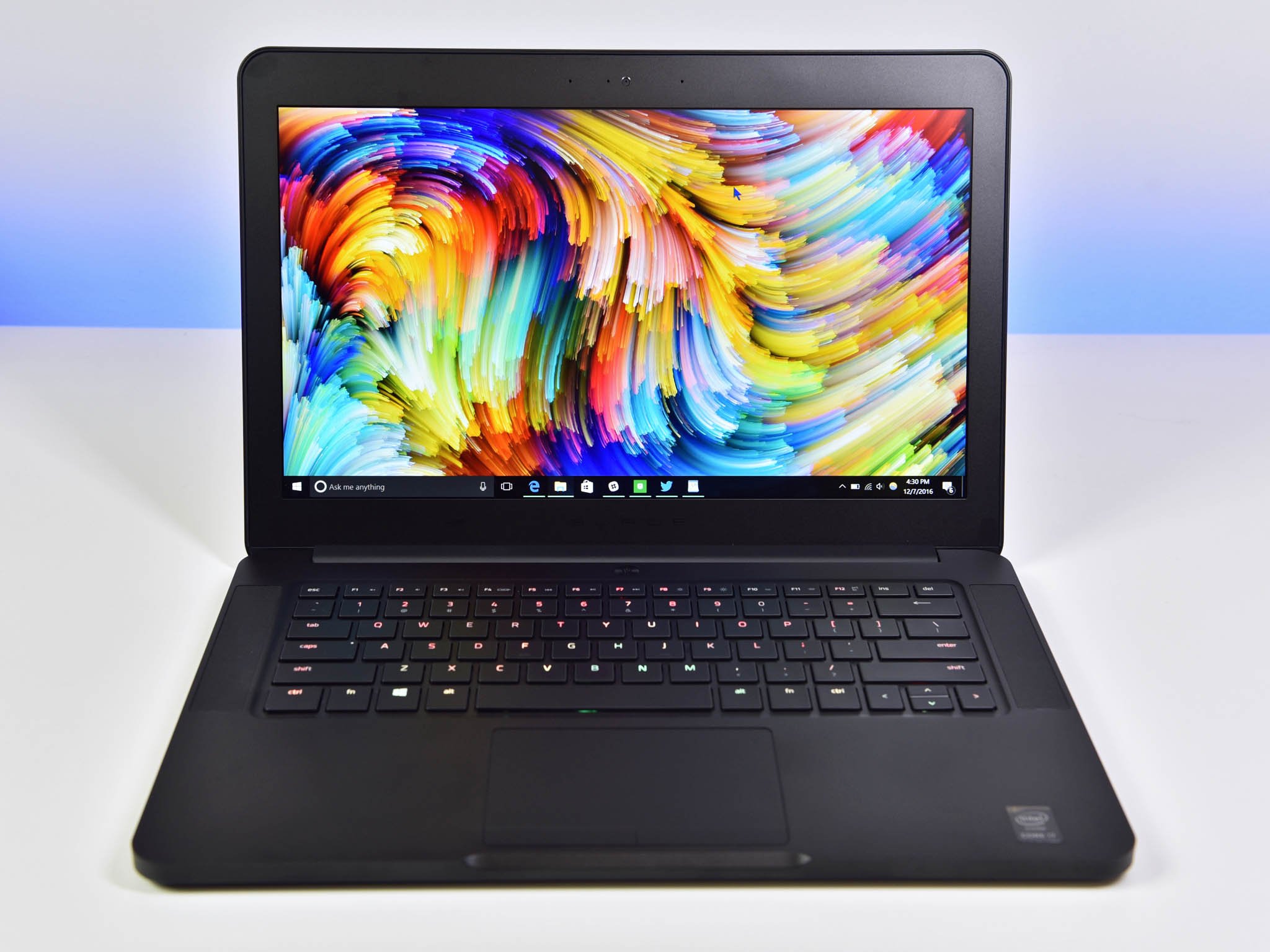
Razer recently refreshed its Razer Blade 14-inch gaming laptop with an updated Intel processor. Voted by the staff here at Windows Central as one of the best gaming laptops (due to its size and build quality), the Blade has a special place in our hearts.
But how big of a deal is the new 2017 Razer Blade with a 7th-Generation Intel Core i7-7700HQ ("Kaby Lake") versus the late-2016 version with a 6th-Generation Intel Core i7-6700HQ ("Skylake")? And is there anything else that is new?
I've been testing and benchmarking both PCs during the last week, and the results are surprising.
Razer Blade 2017 specs
- Display:
- 14-inch Full HD (1920 x 1080) matte non-touch
- 14-inch IGZO 4K (3840 x 2160) glossy touch
- Processor:
- Intel Core i7-7700HQ 2.8GHz (Turbo to 3.6GHz).
- 16GB DDR4 RAM
- NVIDIA GTX 1060 6GB graphics
- Storage and Ports:
- Up to 1TB NVMe SSD
- Thunderbolt 3 (USB-C)
- 3 x USB 3.0 port
- HDMI 2.0
- Headphone and microphone combo
Enhancements in the Razer Blade 2017
There are a few areas that are new in the 2017 Razer Blade. Here's a quick overview of what's different:
- Faster CPU.
- Slightly faster RAM.
- New 4K display option (coming soon).
- New options in Razer Synapse software.
- Quieter fans and no "coil whine."
The 2017 Razer Blade should be categorized as a refresh rather than an "all new" PC, because only some of the components have been updated. Nevertheless, the new processor matters.
Not much has changed regarding the late-2016 edition, so you can read our full and in-depth review of that device for the things I skip here, such as the display, keyboard and ports. I'm focusing here on what is new and different with the 2017 edition.
Newer, faster Intel processor
The new Razer Blade 14 for 2017 features a refreshed quad-core 7th-Generation Intel Core i7-7700HQ processor with a stock core clock at 2.8 GHz and a Turbo up to 3.6 GHz. That stands in comparison to the late-2016 Razer Blade 14 with a 6th-Generation Intel Core i7-6700HQ with a core clock of 2.6 GHz and a turbo up to 3.2 GHz. Both chips use the 14-nm manufacturing process and have a 45W thermal design power (TDP).
CPU differences
| Device | Processor | Generation | Dev Name | Core Clock | Turbo Clock | Cores |
|---|---|---|---|---|---|---|
| Razer Blade 2017 | Intel Core i7-7700HQ | Seventh | Kaby Lake | 2.8 GHz | 3.6 GHz | 4 |
| Razer Blade late-2016 | Intel Core i7-6700HQ | Sixth | Skylake | 2.6 GHz | 3.2 GHz | 4 |
Another significant difference with the newer Kaby Lake Intel chips is 4K media handling via a dedicated media engine (Gen9.5 Media Architecture) found in the Intel HD 630 graphics. This engine boosts performance and power-efficiency but only for content with HEVC 10-bit and VP9. That means for streaming 4K video on YouTube, users should see significantly better battery life with the new Kaby Lake processor compared to last year's Skylake. There is also improved "adaptive performance" for things such as Turbo Boost, to improve overall performance and responsiveness.
Of course, both gaming laptops have discrete GPUs with the NVIDIA GTX 1060 – which has not changed – so most of the GPU punch will remain the same between them.
Overall, Intel's 7th-Generation Kaby Lake is a modest improvement over last year's Skylake implementation. It's best to consider it an optimizing release rather than one for a big performance boost.
Improved battery life in some scenarios is expected, along with slightly better thermal regulation, and improved 4K handling of streaming content. The most visible impacts, however, are the jump in speed (2.6 GHz to 2.8GHz) and improved Turbo ceiling (3.2 GHz to 3.6 GHz).
While those speed increases are nice in synthetic benchmarks, they do not significantly impact results. A different story is told, however, in real-world gaming.
Quieter fans and improved cooling
One of the biggest complaints about the late-2016 Razer Blade is that the fans, even on idle or light processing (like web browsing), would always be buzzing. Being a gaming laptop squeezed into a thin, metal body with a NVIDIA GTX 1060, none of that surprised or bothered me, but it did for others. You don't have to look far in forums to see some user complaining about the fans always being on in the late-2016 Razer Blade.
The 2017 Razer Blade solves this problem. It appears that the cooling curve has been shifted with the fans turning on less frequently. When in idle or low CPU scenarios the fans completely turn off. It's dead quiet, and it's a welcome change.
Interestingly, the CPU temperatures are higher with the CPU idling, averaging about 125 degrees F (52 degrees C) on the Kaby Lake version versus the 100 degrees F (38 degrees C) Skylake. In other words, all that fan whirring keeps the late-2016's processor very cool. The question: Is that really necessary?
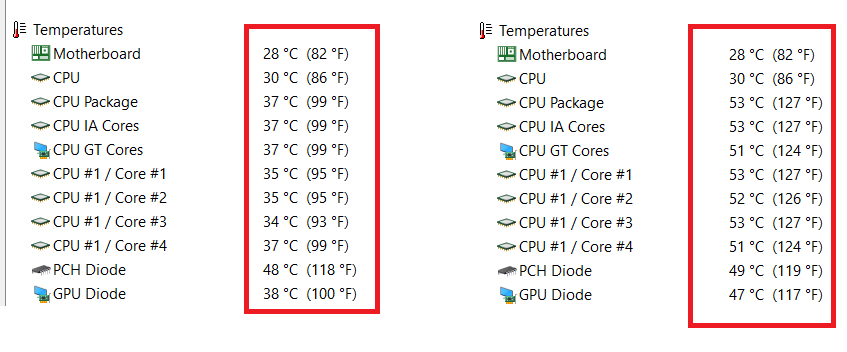
Razer is considering a "fix" for the late-2016 Razer Blade's loud fans, but it is not yet evident that it can change much if the issue is hardware related or restricted.
I am not saying that the new 2017 Razer Blade is hotter when it comes to the chassis, which feels the same when in use and is quite cool to the touch. Also, all bets are off when gaming, because both laptops sound like small hairdryers when that GTX 1060 kicks into full gear and you max out the CPU.
Finally, the new 2017 edition appears to have no coil-whine issues. I'm immune to those high frequencies, so I am not bothered by coil whine. I even have a difficult time identifying it. Nonetheless, a cursory search of Razer's forums, Reddit, and other places suggest people are quite happy with the lack of coil whine in this year's model. Razer recently released a new BIOS for the late-2016 edition that addresses coil whine, as well.
Razer Blade 2017 is cooler than you think
Despite the fans being off during low CPU usage on the new 2017 Razer Blade, it runs, overall, cooler than the late-2016 version when under significant CPU and GPU load.
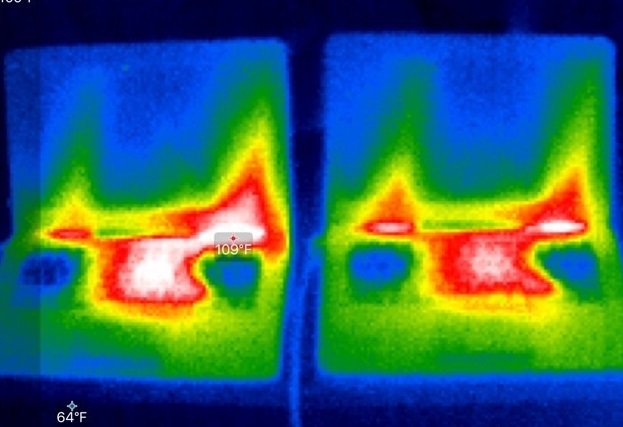
Running a 3DMark "stress test" for twenty minutes revealed that, on average, the 2017 Razer Blade ran about 10 degrees cooler than the late-2016 version.
Looking at the thermal images, the visible hot-spots peaking in white are very evident in the laptop on the left, in both images, which is the late-2016 Razer Blade.
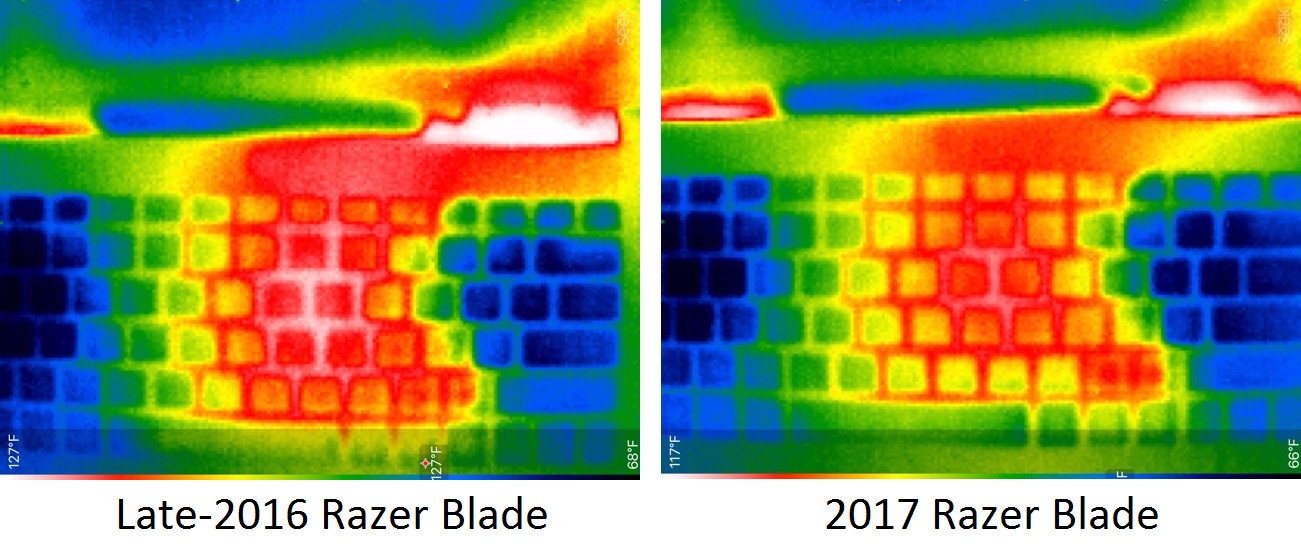
The peak temperature of the chassis (upper keyboard deck) was observed after twenty minutes of testing:
Infared thermal testing - Seek Camera
| Laptop | Peak temperature |
|---|---|
| Razer Blade 2017 | 120°F (49°C) |
| Razer Blade 2016 | 131°F (55°C) |
A difference of ten degrees is very significant and can make the difference between comfortable and uncomfortable for gaming.
New Synapse features
Related to the improved cooling and lower fan usage the 2017 version, the Razer Blade has two new features in the Razer Synapse software. That software lets you control the Blade's Chroma lighting, power usage, and optionally sound (if installed). Here is what's new:
- Fan Speed: New options include "auto," "low" and "high," versus old options with just "quiet mode" and "cool mode." (The default is "auto.")
- Power Control: "Balanced" for both battery and charging, and "battery saver," which disables keyboard backlight and adjusts power settings to extend battery life. (An earlier version of the app said it disabled the GPU, too, but that text has been removed with a recent Synapse update.)
I asked Razer whether those features will be coming to other Razer laptops and the answer, for now, is "no official word on future models." The reason for the shift was "… we wanted to give more power options for users like Windows settings itself."
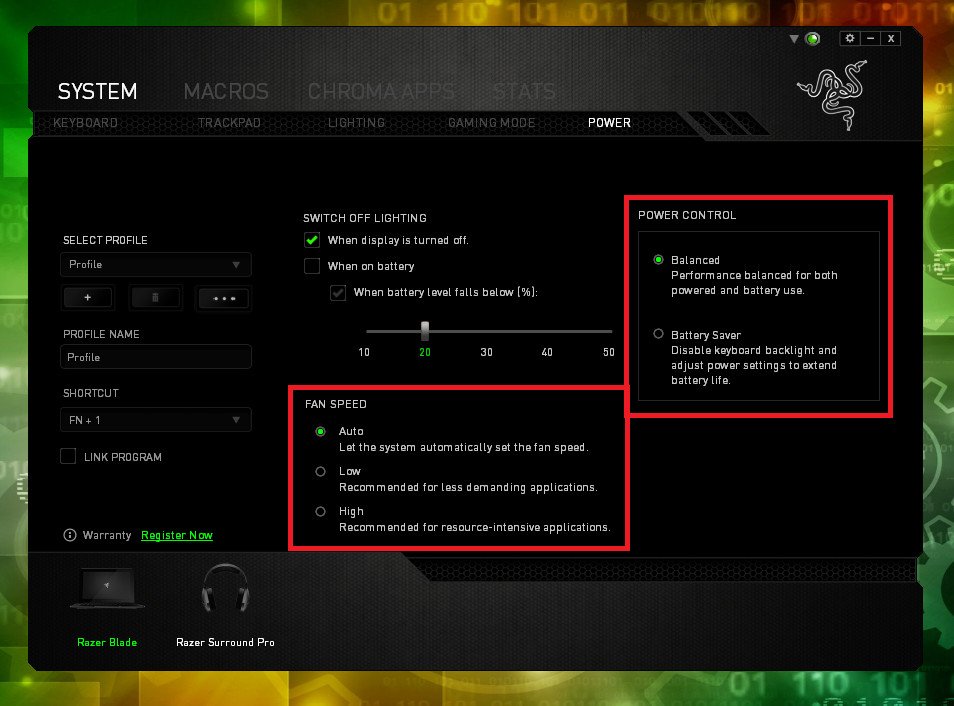
In my testing, I did not notice a massive difference with the "balanced" versus "battery saver," which seems to reflect the native Windows Power Profiles. In theory, however, when pushing the CPU and GPU under gaming in battery saver the system won't work as hard extending battery life. If you're just using the Razer Blade for light computing, battery saver will only extend things by a modest amount.
Faster RAM
Razer bumped the 16GB of DDR4 RAM, which is still soldered on and cannot be replaced, from 2,133 MHz to faster 2,400 MHz components.

While not a massive shift, that extra boost, when combined with the new processor, gives a little extra edge to the 2017 Razer Blade.
Everything else is the same
Nothing else has changed in the 2017 edition of the Razer Blade.
Razer did bump the display from a glossy IGZO QHD+ (3200 x 1800) to a new a 4K (3840 x 2160) version, but that model is not yet available. For my testing (and personal preference) I prefer the Full HD (1920 x 1080) matte Razer Blade, and that panel is not any different this year.
The new Razer Blade still features Killer Wireless AC-1535, the same size 70WHr battery, the same non-Precision touchpad, and the laptop is physically identical in every way. The NVIDIA GTX 1060 with 6GB of video RAM is also unchanged.
Storage options still vary depending on the size you order. Versions with 512GB and 1TB sometimes get the new Samsung PM961 PCIe SSD, while others get the PM951, often due to a general shortage of components in the industry right now. (HP and Dell do this, too.)
How to upgrade the Razer Blade with a Samsung 960 EVO SSD
Of course, you can easily replace the SSD at any time if you need a faster or larger drive.
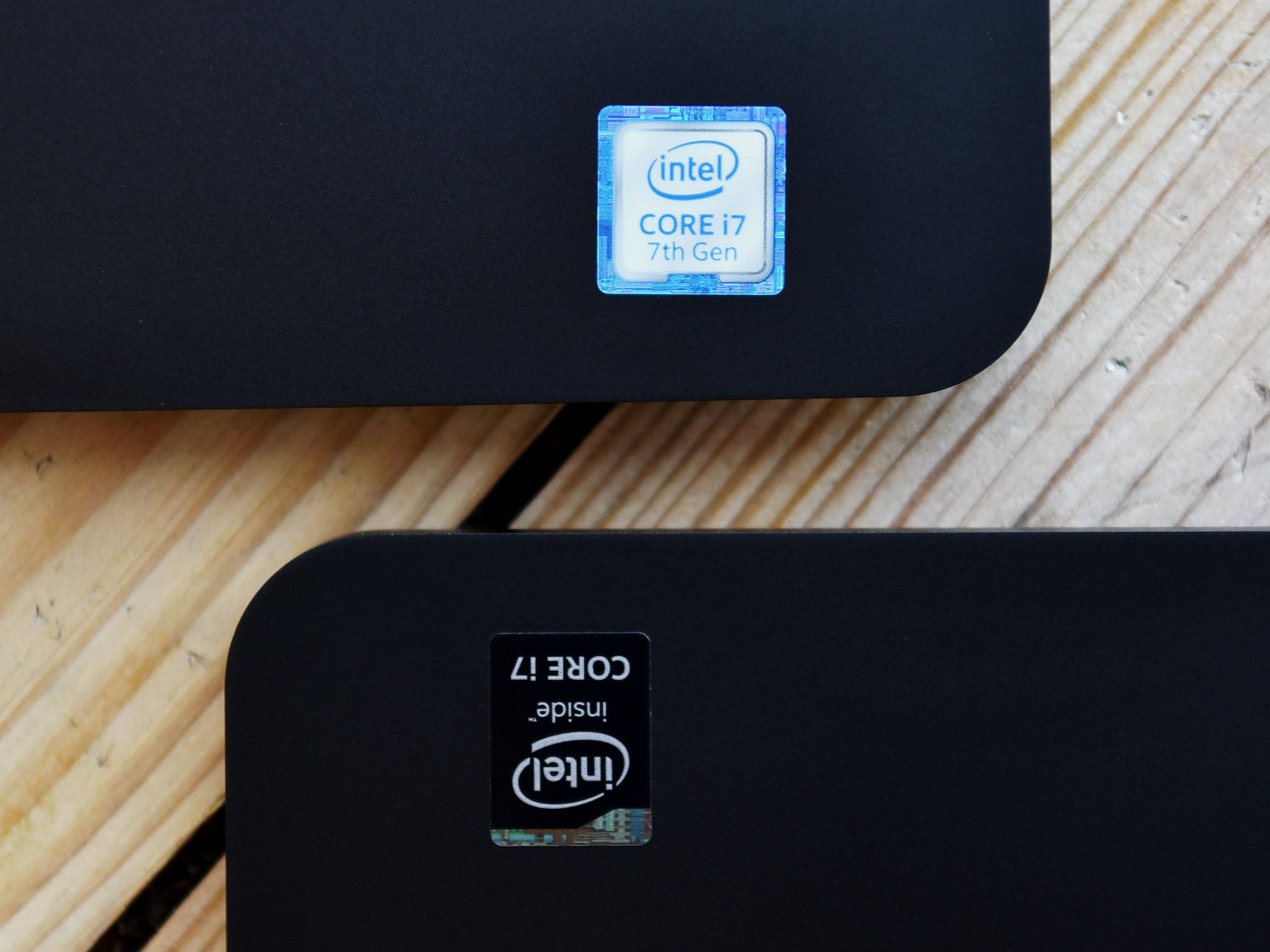
Finally, I should mention that Razer now uses the standard Intel sticker on the keyboard deck. That differs from the traditionally uber-cool, all-black Intel decal that was used previously. And that's super lame.
Benchmarking "Kaby Lake"
The biggest shift with the 2017 Razer Blade is the Intel processor. While the 7th Generation iteration of the Core-i series is an "optimizing release" it matters, due to the higher clock rate.
Here are some synthetic benchmarks to quantify the differences between this year's quad-core processor and last year's "Skylake" version.
Geekbench 4.0 benchmarks (higher is better)
| Laptop | Single core | Multi core |
|---|---|---|
| Razer Blade 2017 | 4,277 | 13,597 |
| Razer Blade 2016 | 3,774 | 12,638 |
| XPS 15 (9560) | 4,503 | 13,587 |
| Razer Blade Pro | 3,660 | 12,325 |
| Spectre x360 15 | 4,098 | 8,022 |
Geekbench is more CPU intensive than GPU, and the results reflect that.
PCMark - Home Conventional 3.0
| Laptop | Score | Comparison |
|---|---|---|
| Razer Blade 2017 | 3,448 | Better than 71 percent of all results |
| Razer Blade 2016 | 3,280 | Better than 67 percent of all results |
| XPS 15 (9560) | 3,534 | Better than 71 percent of all results |
| Razer Blade Pro | 3,223 | Better than 63 percent of all results |
| Spectre x360 15 | 2,472 | Better than 41 percent of all results |
Again, while not a huge shift PCMark's Home Conventional 3.0 test demonstrates a measurable difference in overall system performance.
Geekbench 4.0 CUDA (higher is better)
| Laptop | GPU | Score |
|---|---|---|
| Razer Blade 2017 | GTX 1060 | 138,758 |
| Razer Blade 2016 | GTX 1060 | 139,603 |
| XPS 15 | GTX 1050 | 75,636 |
| Spectre x360 15 | GT 940m | 28,868 |
CUDA scores show no discernible difference, which is expected because the GTX 1060 is the same between the two models. Since CUDA is very GPU dependent that is not surprising.
3DMark - Time Spy (higher is better)
| Laptop | GPU | Score |
|---|---|---|
| Razer Blade 2017 | GTX 1060 | 3,639 |
| Razer Blade 2016 | GTX 1060 | 3,458 |
| Dell XPS 15 (9560) | GTX 1050 | 1,789 |
| Surface Book | GTX 965M | 1,531 |
| Spectre x360 | GT 940m | 613 |
Broken down, the Razer Blade 14 with Kaby Lake scored 5.2 percent higher on Time Spy than the Skylake version. Most of that fell on the CPU increase, which gave the Kaby Lake version a 12.7 percent boost over Skylake. Since these graphics tests also involve the CPU, that translates into around a 4 percent difference in frame rates, which is not much at all: 22.55 FPS versus 23.59 FPS, or about one extra frame per second (FPS). This improvement was not enough to shift the overall "better than" score for both laptops, as they both rank as "28 percent better than all results".
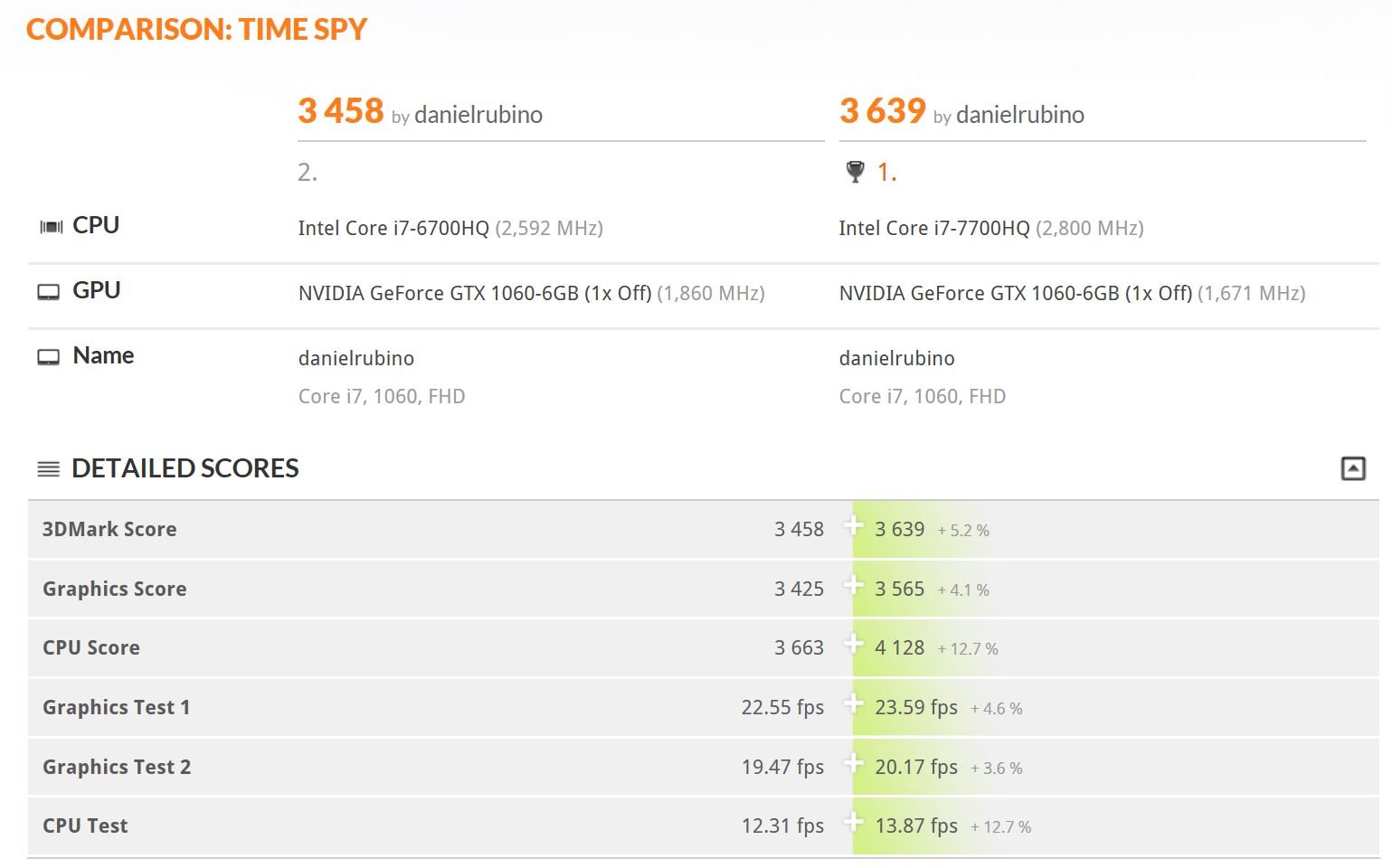
Looking at the CPU-intensive 3DMark API Overhead Test, which tests DirectX 11 and DirectX 12 API calls to the CPU, the Kaby Lake version gets 7.6 percent and 10.4 percent better scores, respectively, compared to Skylake.
3DMark - Fire Strike (higher is better)
| Laptop | GPU | Score |
|---|---|---|
| Razer Blade 2017 | GTX 1060 | 9,278 |
| Razer Blade 2016 | GTX 1060 | 8,665 |
| Razer Blade Pro | GTX 1080 | 12,976 |
Fire Strike, which is for intensive gaming PCs, shows the 2017 Razer Blade with a 15 percent higher score than last year's model. For the GPU, the new Blade 14 averaged 19.58 FPS versus the 17.04 FPS in the older Skylake model.
Overall, the synthetic benchmarks reveal a slight but measurable improvement with the 2017 Razer Blade over the model from late-2016. That advantage is attributable to the higher base and turbo clock rates in the 7th-Generation Intel processor. Still, let's see how those differences manifest themselves in real-world gaming tests.
Real world gaming is a different story
Looking at real-world gaming, we can see how Rise of the Tomb Raider and Gears of War 4 differ between the two laptops.
First up is Rise of the Tomb Raider, which can scale to very high resolutions and detail. Using the pre-set at very high for graphics and toggling vertical sync I get the following results:
Rise of the Tomb Raider UWP
| Laptop | Resolution | Graphics presets | V-Sync | Overall Score |
|---|---|---|---|---|
| Razer Blade 2017 | 1920 x 1080 | Very High | OFF | 68 FPS |
| Razer Blade 2017 | 1920 x 1080 | Very High | ON | 58 FPS |
| Razer Blade 2016 | 1920 x 1080 | Very High | OFF | 57 FPS |
| Razer Blade 2016 | 1920 x 1080 | Very High | ON | 53 FPS |
That's a significant difference and not just two or three FPS. Instead, with the Kaby Lake version, you can run Rise of the Tomb Raider with graphics at very high with vertical sync on and still get nearly 60 FPS. The real difference comes down to disabling vertical sync, where there is a 10-FPS difference between the two PCs.
Still, you could argue that the differences keep the Skylake version well within range of Kaby Lake for Rise of the Tomb Raider. That all changes for Gears of War 4:
Gears of War 4 UWP
| Laptop | Resolution | Graphics presets | V-Sync | Average frame rate |
|---|---|---|---|---|
| Razer Blade 2017 | 1920 x 1080 | Ultra | OFF | 71 FPS |
| Razer Blade 2017 | 1920 x 1080 | Ultra | ON | 60 FPS |
| Razer Blade 2016 | 1920 x 1080 | Ultra | OFF | 51 FPS |
| Razer Blade 2016 | 1920 x 1080 | Ultra | ON | 47 FPS |
I re-ran these benchmarks three times during a few days and cannot believe the difference. With vertical sync off there is a 20-FPS difference on ultra-settings. With vertical sync the Razer Blade with Kaby Lake cruises at 60 FPS without problems, whereas the Skylake version peaks at 47 FPS.
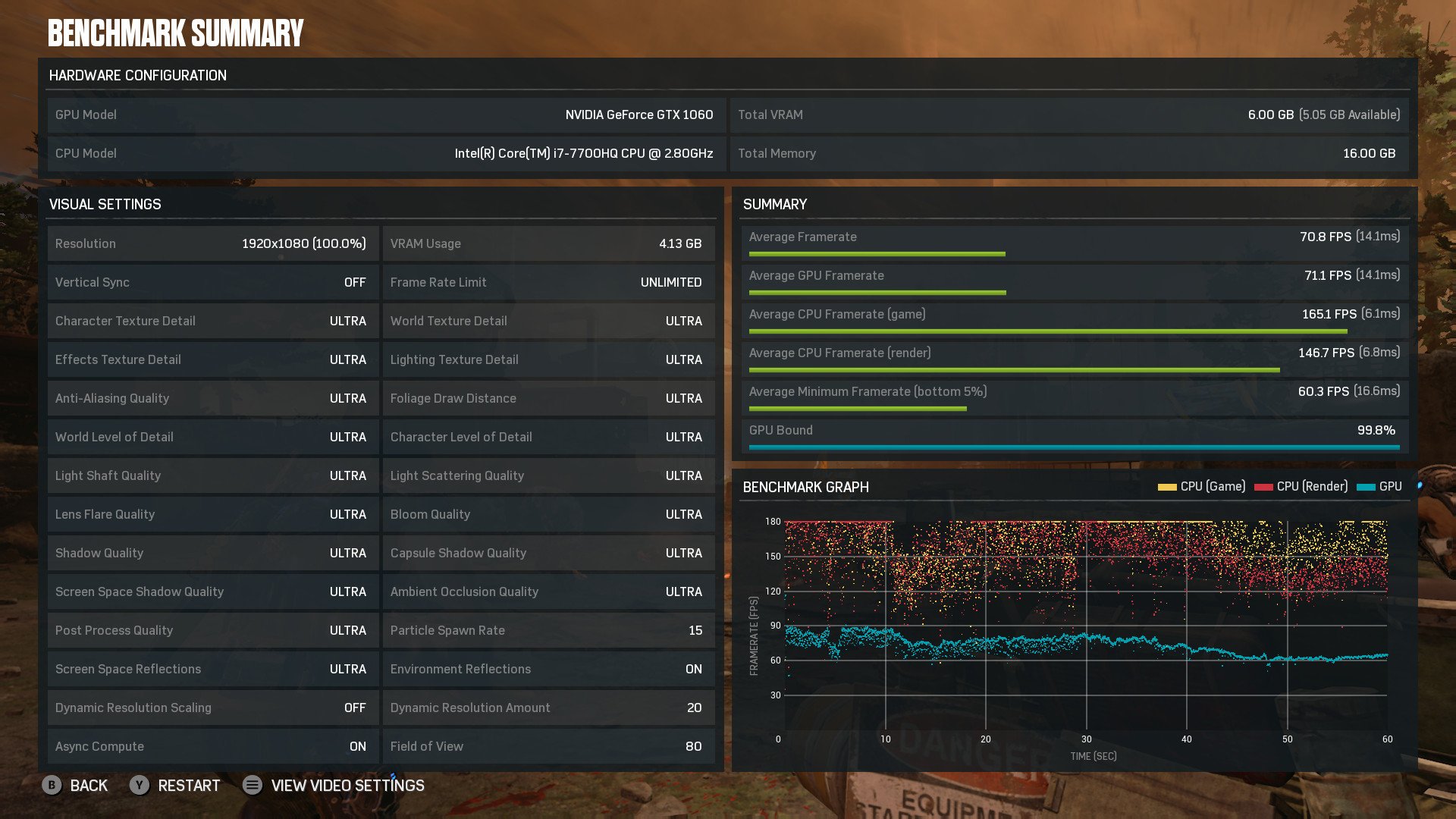
Those results tell a very different story from raw benchmarks. Some games balance the "CPU versus GPU intensity" differently, with some games relying more on the processor than pure graphics processing. That's the case, evidently, with Gears of War 4 where that extra 400 MHz in CPU boost makes a massive difference.
Finally, we also benchmarked Civilization VI using the in-game tools, which include a graphics and AI turn-taking test. Settings were maxed (ultra/ultra) with vertical sync off, on what is a more CPU intensive task.
Sid Meier's Civilization VI
| Laptop | Test | Graphics presets | Score |
|---|---|---|---|
| Razer Blade 2017 | Graphics | Ultra/Ultra | 22.51ms |
| Razer Blade 2016 | Graphics | Ultra/Ultra | 38.45ms |
| Razer Blade 2017 | AI Turn | Ultra/Ultra | 24.28ms |
| Razer Blade 2016 | AI Turn | Ultra/Ultra | 35.37ms |
Something like DOOM (2016), which is more difficult to benchmark, can be played on ultra settings using OpenGL, and it still achieve an average of 90 FPS, with peaks at 110 measured using FRAPS. That's about an extra 10 to 15 FPS over the late-2016 Razer Blade.
It should be clear from the synthetic and in-game benchmarks that the processor (and RAM) boost push the 2017 Razer Blade even further than last year's model.
The one thing to keep in mind is that some games are more CPU intensive than others. That means your experience will vary depending on what you play. Newer games tend to rely on the GPU more, which is why it is hard to say across the board what the performance difference will be between the two laptops.
However, it is safe to say improved gaming performance will be noticeable and measurable in most modern games.
Razer Blade 2016 vs. Razer Blade 2017: A noteworthy upgrade
The 2017 Razer Blade is a notable upgrade over last year's late-2016 version, which is only a few months old. I was not expecting such an improvement in real-world gaming, and I'm pleasantly surprised.
Nonetheless, perspective is important. While playing Gears of War 4 on ultra settings (versus high) is impressive, keep in mind that you are likely playing on a 14-inch display. It's questionable whether you can notice the difference when playing a high-intensity game. (I really can't.)
That dynamic shifts if you opt to use an external display, of course, and there the extra boost in performance and visual acuity could matter.
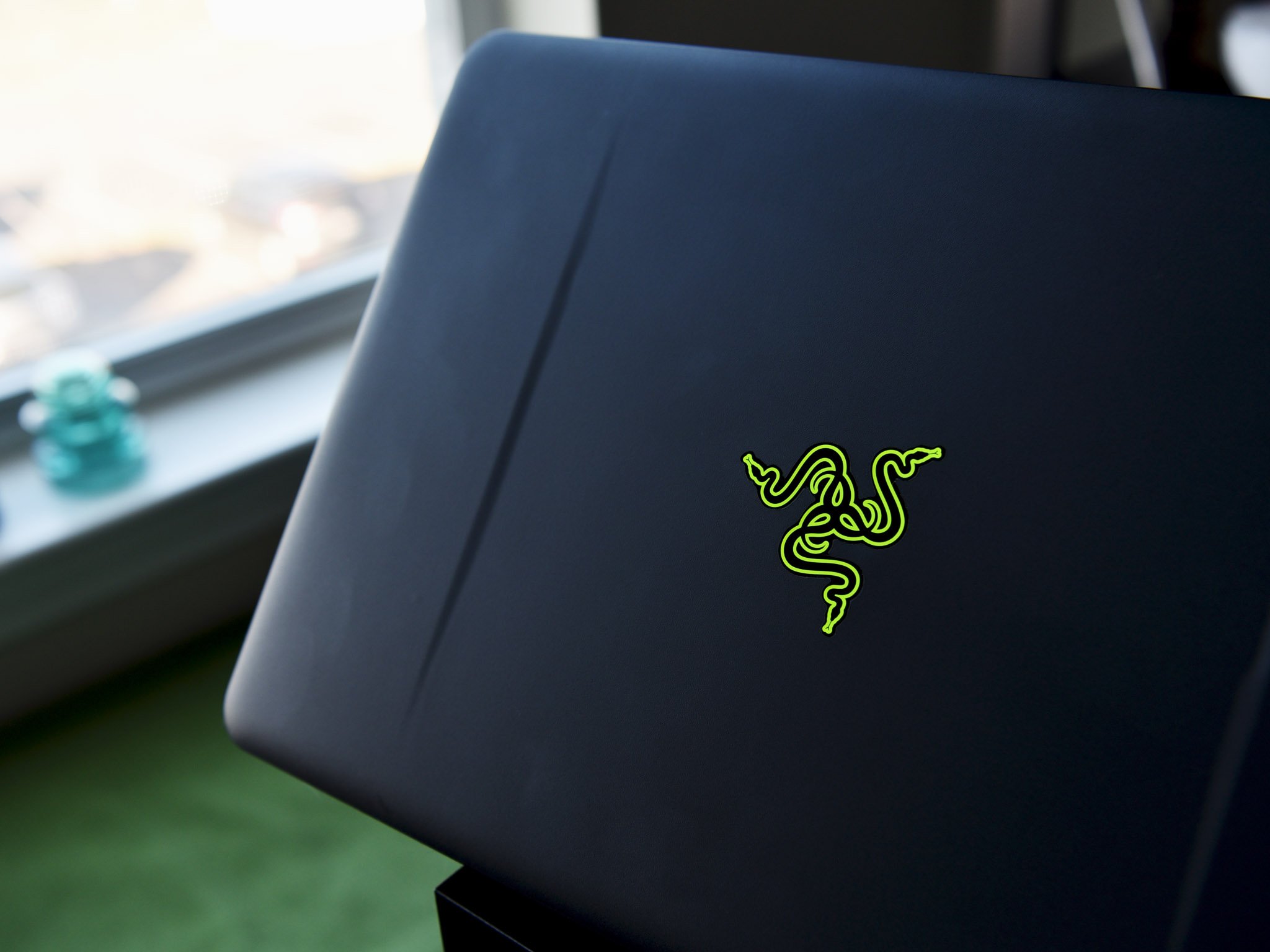
Perhaps the bigger deal are the silent fans during regular, non-gaming usage. While the fans can still rev up when doing more intensive tasks, it is awesome to use the Razer Blade as a regular, quiet laptop. For students in class or those who bring their Blade to the office, this improvement is significant and highly welcomed.
Battery life is also slightly better. The Full HD version here pushes out an extra 30 to 45 minutes in usage. I think it's safe to say that seven hours of light computing (with the display at 20 to 30 percent brightness) is now possible.
Razer Blade (late 2016) second opinion: a full HD gaming powerhouse
So should YOU upgrade from the late-2016 Razer Blade?
I know that's the question some are asking, and it must be frustrating because the late-2016 laptop is only a few months old. In many ways, the new 2017 edition is significantly better. If you can sell off your "old" Blade and eat a few hundred dollars for the new one, I think it's worth it. The quieter fans and improved gaming are striking. Still, it's not a night versus day situation. Razer could also improve the fans in the late-2016 version through a firmware upgrade, knocking out one of the two reasons to get the refreshed model.
Bottom line: Whether you are buying your first Razer Blade, or can upgrade to the 2017 version, you won't be disappointed in the latest PC. While the changes are modest, they make a big difference in the end, and the new Blade is even better than the last one.
Now, if the company could only fix those goofy bezels ...
Pros:
- Significantly improved gaming.
- Silent fans during idle yet runs cooler under load.
- No coil whine.
- Slightly faster RAM.
- New 4K display option. (We did not test this.)
Cons:
- Massive bezels are still unappealing.
- Secondary functions do not light up on keyboard.
- No Precision touchpad.

Daniel Rubino is the Editor-in-chief of Windows Central. He is also the head reviewer, podcast co-host, and analyst. He has been covering Microsoft since 2007 when this site was called WMExperts (and later Windows Phone Central). His interests include Windows, laptops, next-gen computing, and wearable tech. He has reviewed laptops for over 10 years and is particularly fond of 2-in-1 convertibles, Arm64 processors, new form factors, and thin-and-light PCs. Before all this tech stuff, he worked on a Ph.D. in linguistics, performed polysomnographs in NYC, and was a motion-picture operator for 17 years.
